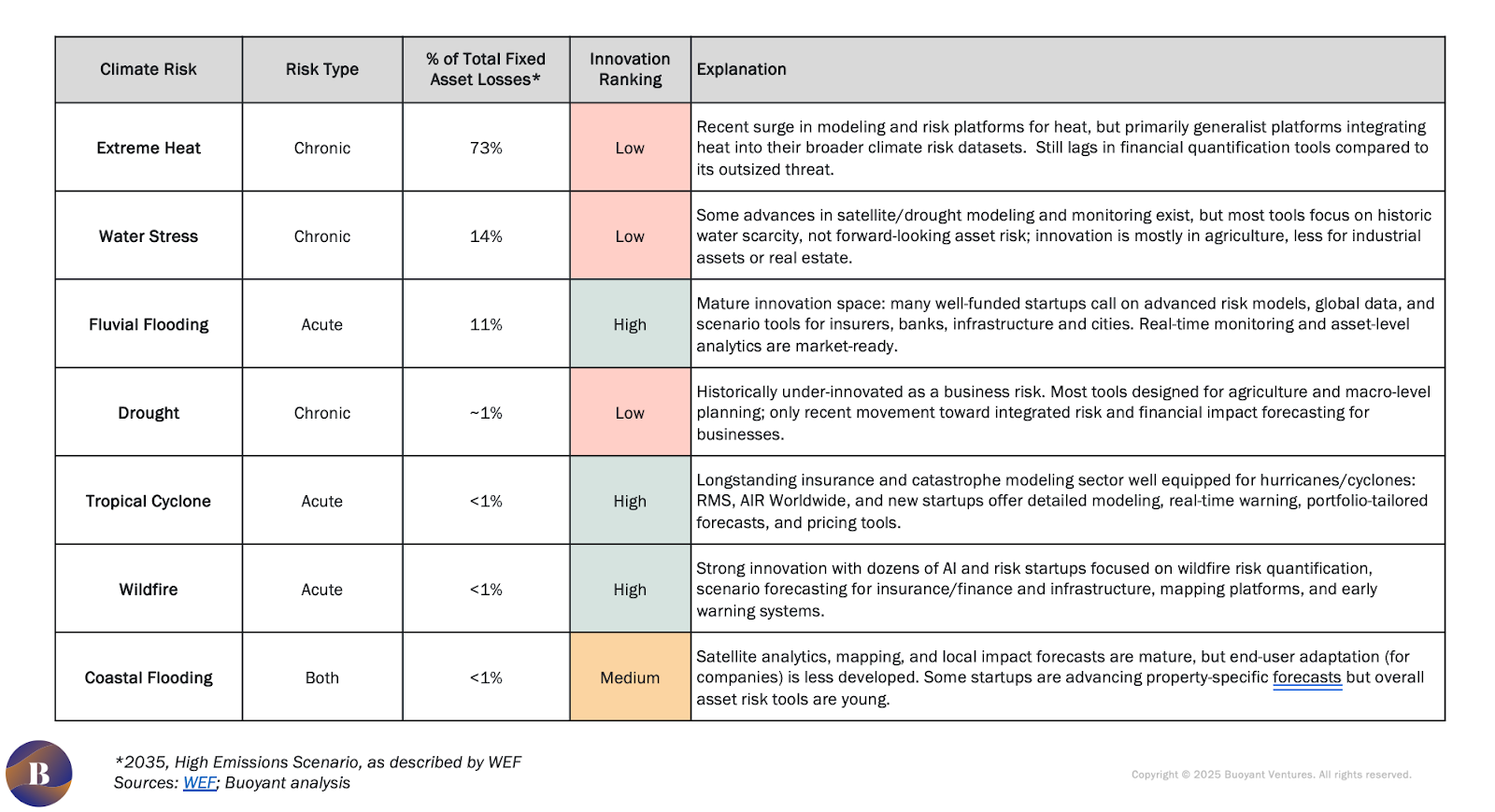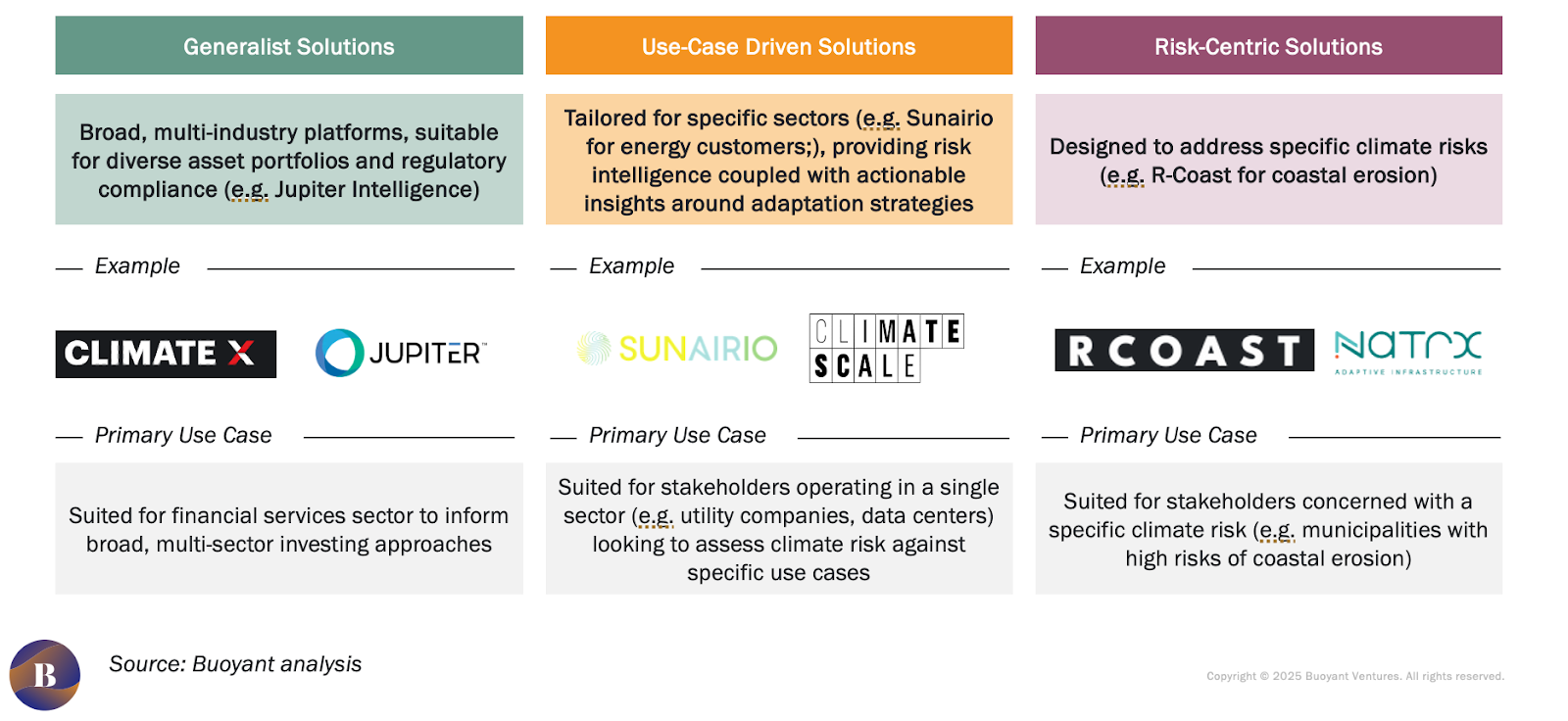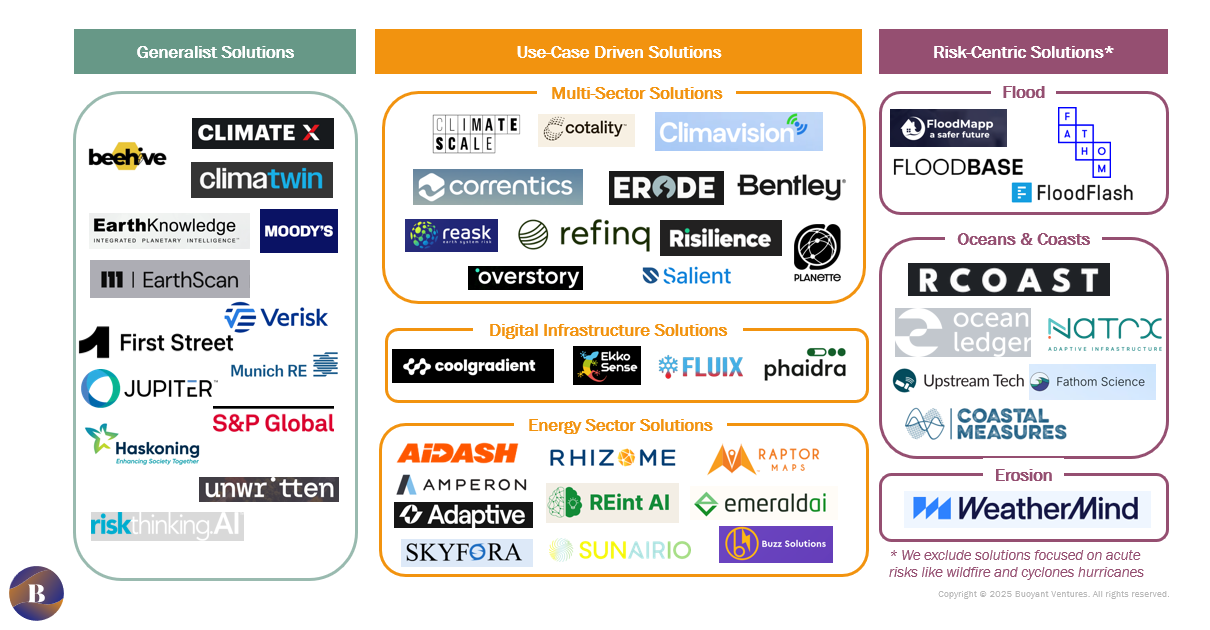.webp)
Beyond the Climate Headlines: Analyzing the Investment Gap Around Chronic Risks
Climate Risk: More Than a Regulatory Checkbox
As climate change accelerates, businesses and investors are waking up to an urgent reality: chronic climate risks are not just distant worries but central threats to financial stability. While dramatic events like wildfires and hurricanes often dominate headlines, it’s the relentless, slow-burning hazards—such as extreme heat and water stress—that quietly erode asset values and challenge the resilience of entire industries.
In recent years, the idea that climate resilience is no longer a nice-to-have, but a central fiduciary responsibility, has taken hold. Since 1980, the U.S. has experienced 403 weather and climate disasters where damages exceeded $1B. Most fixed asset losses are increasingly linked to chronic climate risks, with projections suggesting global financial asset values could shrink by as much as $24 trillion if these threats go unmanaged.
Yet many organizations remain reactive, deciding to assess their climate exposure only after regulations tighten or disasters strike. Regulatory uncertainty, especially in the U.S., creates further hurdles to widespread adoption and rhetoric around climate risk, leaving companies scrambling without the expertise or tools to align climate risk assessment with core business strategies.
Chronic vs. Acute: Two Sides of the Climate Risk Coin
Understanding physical climate risk requires distinguishing between acute risks—sudden, catastrophic events like floods, wildfires, or tropical cyclones—and chronic risks, which build gradually through long-term shifts like rising temperatures and persistent drought.
While both types of risks pose significant hazards, chronic risks, including extreme heat, water stress, and drought, will account for over 90% of estimated fixed asset climate losses in coming decades. Industries heavily reliant on physical infrastructure — telecommunications, utilities, and energy — face annual climate-driven asset losses up to $563 million per company by 2035.
Beyond this, chronic risks pose an extreme threat to human and planetary health. Extreme heat now ranks as the deadliest weather hazard worldwide, causing nearly half a million deaths annually. Its financial toll ripples through health systems, labor productivity, supply chains, and equipment durability. Water stress and flooding also cause widespread disruption, escalating migration, damaging infrastructure, and driving up insurance costs.
Mismatch Between Major Climate Risks and Innovation Investment
Despite the devastating nature of these hazards, there’s a striking disconnect between the scale of climate risks and capital flows. First and foremost, the climate sector is severely underfunded. According to the Climate Policy Initiative, annual climate finance doubled between 2018 and 2022; yet, to meet the estimated $7.4 trillion needed each year through 2030 to stay within a 1.5°C pathway, finance must increase fivefold.
Within these funding flows, climate adaptation is particularly under-resourced: only an estimated 5% of climate finance goes to adaptation, while over 90% flows to mitigation. A core part of adaptation is understanding and analyzing climate risks. Within the already underfunded market, the majority of innovation capital is flowing to highly publicized acute risks, while chronic risks remain severely underserved:

- Extreme heat dominates projected losses, accounting for roughly 73% of fixed asset losses by 2035 under a high-emissions scenario, yet remains underserved in innovation. Most tools treat heat as part of broader climate risk datasets rather than developing specialized financial quantification or adaptation solutions tailored for heat’s outsized impact.
- Water stress accounts for about 14% of losses but attracts limited innovation capital. Though advances exist in historic irrigation monitoring and agricultural models, there are comparatively few forward-looking tools evaluating water risk for industrial assets or commercial real estate.
- In contrast, risks like fluvial flooding (11%), tropical cyclones (<1%), and wildfires (<1%) have well-funded innovation ecosystems. These acute hazards benefit from mature real-time monitoring, predictive analytics, insurance modeling, and scenario-planning tools that are market-ready and are actively being considered among insurers and financial services providers.
This mismatch leaves sectors most vulnerable to chronic threats without targeted, actionable solutions. For investors and industry leaders, this gap highlights a clear opportunity to focus on both sides of the climate risk coin. Acute events, while also disastrous and tragic, attract disproportionate innovation attention. There is a gap in the market for solutions that prioritize chronic risks—delivering granular, asset-level insights and long-term adaptation strategies that truly address the scale and duration of chronic climate impacts.
The Rise of Climate Risk Intelligence for Chronic Risk
Climate Risk Intelligence (CRI) aims to bridge gaps by collecting, analyzing, and translating complex climate data into actionable insights for decision-makers. Powered by AI, machine learning, satellite data, and integrated enterprise systems, CRI capabilities have significantly increased in the past few years.
Buoyant published our first research on the CRI landscape in 2021, however given developments in the sector, we are in the process of doing a research refresh focused on distinct applications of CRI. To kick off this refresh, we focused on identifying practical applications for assessing chronic risk, a subset of the broader CRI landscape.
Within this context, solutions can be segmented into three main categories:
- Generalist Solutions: Broad, multi-industry platforms supporting regulatory compliance and portfolio-level risk management.
- Use-Case Driven Solutions: Tailored for specific sectors like energy and digital infrastructure, offering customized insights and adaptation strategies.
- Risk-Centric Solutions: Focused on individual hazards such as flooding or coastal erosion, delivering specialized risk assessments.

Applications range from asset risk modeling and predictive analytics to scenario planning, supply chain resilience, and climate-related disclosures.
Investment Outlook: Proceed with Patience & Purpose
Despite rapid technological advances and rising demand, the CRI market is crowded and competitive. In our research, we discovered that the majority of solutions cover both acute and chronic risks. Furthermore, most end users prioritize actionable insights that solve their pain points, and don’t necessarily focus on the distinction between chronic and acute risk.
The most promising investment opportunities are emerging from solutions adopting a “bottoms-up,” use-case-driven development approach. Instead of starting with climate data and developing broad cross-sector applications, use-case driven solutions are designed to address a specific pain point and leverage climate data to address that pain point. Such solutions deliver tailored, practical insights for industries or risk areas where chronic climate risks threaten financial and operational stability.
Given the broad landscape of CRI solutions, we focused market mapping on solutions that address specific use cases for the energy and digital infrastructure sectors.

There’s no shortage of AI-driven climate models on the market, but those lacking clear ties to end-user value may struggle to scale. The real opportunity lies with companies that can translate complex climate science into actionable insights for sectors most exposed to chronic climate threats.
Buoyant Perspective
Since our launch in 2020, Buoyant has monitored and made investments in the CRI space. Given the evolving climate and burgeoning innovation landscape, we are committed to updating our research and providing nuanced insights into how CRI is developing and being used by businesses to drive decisioning.
As the climate crisis deepens, businesses face a stark choice: lead with proactive, chronic risk-informed strategies or risk falling behind in resilience and financial viability. Climate risk intelligence offers a crucial pathway to navigate this new reality, but bridging the innovation gap—especially for the most consequential chronic risks like extreme heat and water stress—is essential.
Businesses that will lead are those that view climate risk not as a compliance exercise, but as a strategic lever, driving long-term value, operational resilience, and durable growth.
Stay tuned for our next deep dive into CRI.




